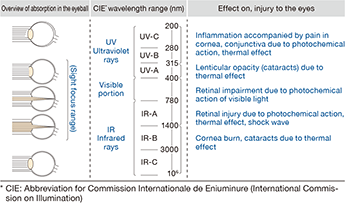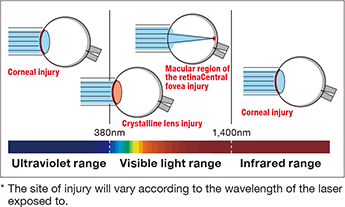Light Sources
Guide
Laser Safety Guide
Hazards of Laser Light
A laser is a special man-made light, with completely different characteristics from natural light. With
directional characteristics, and monochromatic action, power is concentrated and reaches high density from
the focusing effect of lenses. under certain conditions a laser can be so strong that it will melt metal in
an instant.
No matter how well laser workers know these characteristics, if preventive measures are not
taken, it is highly likely that disasters can occur with serious bodily harm and lasting effects.
Effects of Laser Light on the Human Body
JIS C6802, the safety standards for laser products, covers the wavelengths ranging from 180nm and 1m with the
objective of protecting the human body.
As shown in Fig. 1, the position of harm to the eyes is
different depending on the wavelength range of light.
Injury to the Eyes
Most ultraviolet light is absorbed by the surface of the cornea, and a partially transmitted portion is
absorbed by the crystalline lens of the eye.
If exposed to a high output UV laser, tissue is injured due
to photochemical action, inflammation (burns) of the cornea will occur in the short term, while long term
exposure might lead to cataracts due to light action.
Glare is felt immediately, and blinking is a protective response.
However there is a temporal limit, it
takes about 0.25 seconds for the protective response once the hazard is sensed, during which time the laser
enters the eye. Here, the output that is regarded as virtually safe even though the laser enters the eye
within this time is basically 1mW or less. At output above that, the retina (Fig. 2) will receive local
injury due to thermal effects and focusing effect, even permanent impairment might result.
The laser reaches the retina in the same way as the visible light range. A point of particular caution is that in the non-visible light range, injury is received without noticing it, so it is a very hazardous wavelength range for the eyes.


World Safety Standards
[International Organization] IEC60825-1 [Safety of laser
products]
[Japan] JIS C6802 [Safety standards of laser products]
What Are Laser Safety Standards
IEC60825-1 was created as an international standard for laser equipments, and it is a common safety standard for IEC member nations.
What Is IEC60825-1 "?"
The IEC is the
[International Electrotechnical Commission]
As an organization for
international standardization in the electrical and electronic fields, it has the following objectives to
facilitate and promote international commerce.
*The promotion of the formulation and promulgation of international standards for the electrical and electronic engineering technical fields.
On JIS C6802
The Japanese Industrial Standard based on IEC60825-1
As determined by IEC60825-1 a standard to utilize and
manufacture laser products properly world-wide, Japan has also enacted JIS C6802, safety standards for laser
products on that basis.
JIS C6802, a translation of IEC60825-1 which is the international standard, is
deemed "World Common Safety Standards".
The provisions of this standard range from the details of safety
measures required according to the wavelengths and strength of lasers to the hazard display labels, and it
is considered that as long as based on this standard "laser light can be utilized safely".
Classification of Lasers by Class (IEC60825-1)
Each category by class is defined based on AEL (Accessible Emission Limit: the limit of the laser emission level allowed for that laser class).
| Class 1 | Low-power level: Regarded as a safe laser under normal operating conditions ( reasonably foreseeable operating conditions ). |
|---|---|
| Class 1M | Low-power level (wavelengths of 302.5nm - 4,000nm),parallel large diameter beam or divergent
beam Safe with the naked eye, viewing of the laser with optical instruments is hazardous. |
| Class 2 | Low-power visible light (wavelengths of 400nm - 700nm) : The same as a conventional visible light laser, safe with blinking and avoidance. Long-term viewing might cause eye injury, particularly hazardous for long-term viewing of blue light. Power conditions : CW visible light 1mW or less
|
| Class 2M | Low-power visible light (wavelengths of 400nm - 700nm) , parallel large diameter beam or
divergent beam Applied in visible lasers, safe with the naked eye if blinking or avoidance responses are possible. Direct viewing of laser light with optical instruments is regarded as potentially hazardous. |
| Class 3R | Laser light in the wavelengths of 302.5nm - 106 nm , and direct viewing of beams is regarded as potentially hazardous. Power conditions: CW visible light 5mW or less, otherwise within 5 times of Class
1
|
| Class 3B | Direct intrabeam viewing is hazardous. However, viewing of pulse laser emissions by diffuse
reflection not connected to a focal point, is safe under certain conditions.
Power conditions : Light 315nm or greater, CW laser 0.5W or less
|
| Class 4 | Lasers that produce high-output (exceeding the AEL of Class 3B) hazardous diffuse reflection Not merely direct beam contact with the skin or eyes even momentarily is regarded as hazardous, even diffuse reflection is regarded as injurious to skin and eyes. It is also believed to cause fires. |
※ It is important to confirm the class of lasers to be used, and carry out measures to prevent injury.
Measures to Prevent Injury by Laser Classes
Directives from the Ministry of Health, Labor and Welfare [On Measures to Prevent Injury from Laser Radiation] formulate specific details for safety and preventive measures in work with lasers, with laser equipments other than Class 1 and Class 2 as the subject.
| Details of Measures (item only) | Class of Laser Equipment | |||||
|---|---|---|---|---|---|---|
| 4 | 3B | 3R | 2M and 1M | |||
| Assignment of Laser Equipment Managers | ◯ | ◯ | ◯ *1 | - | ||
| Controlled Area (Sign, Keep Out) | ◯ | ◯ | - | - | ||
| Laser Equipments | Laser light path | Position of optical path | ◯ | ◯ | ◯ | ◯ |
| Appropriate design and shielding of optical path | ◯ | ◯ | ◯ *1 | - | ||
| Appropriate termination | ◯ | ◯ | ◯ *1 | ◯ *2 | ||
| Key control | ◯ | ◯ | - | - | ||
| Emergency stop switches, etc. | Emergency stop switches | ◯ | ◯ | - | - | |
| Alarm device | ◯ | ◯ | ◯ *1 | - | ||
| Shutter | ◯ | ◯ | - | - | ||
| Interlock system, etc. | ◯ | ◯ | - | - | ||
| Emission window display | ◯ | ◯ | ◯ | - | ||
| Work Management,Health Management, etc. | Operation position | ◯ | - | - | - | |
| Measures for optical system adjustment | ◯ | ◯ | ◯ | ◯ | ||
| Protective equipment | Protective eyewear | ◯ | ◯ | ◯ *1 | - | |
| Work clothes to reduce exposure of the skin |
◯ | ◯ | - | - | ||
| Use of flame-retardant materials | ◯ | - | - | - | ||
| Inspection and maintenance | ◯ | ◯ | ◯ | ◯ | ||
| Safety and hygiene education | ◯ | ◯ | ◯ | ◯ | ||
| Health management | Examination of anterior eye segments (cornea, crystalline lens of the eye) |
◯ | ◯ | ◯ *1 | - | |
| Examination of the fundus of the eye |
◯ | - | - | - | ||
| Other | Notices | Laser equipment managers | ◯ | ◯ | ◯ *1 | - |
| Precautions for hazards, toxicity and handling |
◯ | ◯ | ◯ | ◯ | ||
| Display of installation of laser equipments |
◯ | ◯ | - | - | ||
| Display of high voltage components of laser equipments | ◯ | ◯ | ◯ | ◯ | ||
| No hazardous materials allowed | ◯ | ◯ | - | - | ||
| Measures for toxic gas, particulates etc. | ◯ | ◯ | - | - | ||
| Medical examination and treatment for those believed injured by laser radiation |
◯ | ◯ | ◯ | ◯ | ||
◯ Indicates that measures are required. Details of the measures summarized by our company
are the details determined in
[Summary of Measures to Prevent Injury from Laser Radiation]. Always refer
to the original document.
*1 Measures are required for laser equipments emitting laser radiation other
than the 400 - 700nm wavelengths.
*2 Regarding laser equipments written in JIS Standard 10.6, measures
are required for ends of laser light path.
Preventive Measures
There is need to enhance safety measures protecting against laser light to avoid grave injuries and
after-effects.
Injuries do not occur merely from exposing the body to laser light, secondary injuries are
also possible from inhaling toxic gases produced by laser light irradiating objects such as workpieces and
peripheral equipment (gases and fine particles).
herefore, there is a need for laser workers and
managers to take a variety of measures to avoid laser accidents.
Windows and curtains made of the similar special materials as laser protective eyewear protect the eyes of not only nearby workers, but also the eyes and skin of people nearby. It is necessary to make a selection based on the type of laser oscillator (wave length) and output power.
Protection of the eyes with eyewear made of special materials is necessary so that laser light does not
accidentally strike the eyes.
It is necessary to make a selection based on the type of laser oscillator
(wave length) and output power.
There are panels and plates to post at the entrances of rooms to inform that lasers are being used in the
vicinity.
These panels and plates need to be posted by users of the laser equipment (device) themselves.
Hazard displays with seals and labels draw attention to the hazard of lasers and processors.
In
compliance with JIS C6802 the manufacturer of the laser equipments must display the seals and labels.

